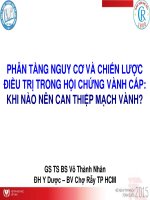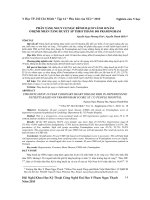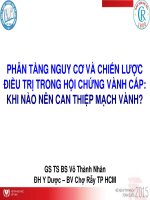Phân tầng nguy cơ trong hội chứng vành cấp
Bạn đang xem bản rút gọn của tài liệu. Xem và tải ngay bản đầy đủ của tài liệu tại đây (2.3 MB, 22 trang )
PHÂN TẦNG NGUY CƠ VÀ CHIẾN LƯỢC
ĐIỀU TRỊ TRONG HỘI CHỨNG VÀNH CẤP:
KHI NÀO NÊN CAN THIỆP MẠCH VÀNH?
GS TS BS Võ Thành Nhân
ĐH Y Dược – BV Chợ Rẫy TP HCM
Calculating GRACE Risk Score
Killip
class
Points
Systolic
BP
Points
Age
Points
I
0
≤70
66
≤30
0
0-0.39
II
17
70-89
53
30-49
10
III
34
90-109
40
50-69
IV
51
110-129
27
≥130
19
Baseline risk factors
Points
Cardiac arrest at admission
38
ST-segment deviation
18
Positive cardiac markers
14
STEMI
14
Total from clinical evaluation
Creatinine Points
Heart
rate
Points
3
≤70
10
0.4-0.9
9
70-89
15
29
1.0-1.9
32
90-109
26
70-79
56
≥2
51
110-129
32
80-89
73
130-149
24
≥90
91
150-169
16
170-199
8
≥200
0
2014 AHA/ACC Guideline for the Management of Patients With Non–ST-Elevation Acute Coronary Syndromes
2015 ESC Guidelines for the management of ACS
without persistent ST-segment elevation
European Heart Journal Advance Access published August 29, 2015
2015 ESC Guidelines for the management of ACS
without persistent ST-segment elevation
2015 ESC Guidelines for the management of ACS
without persistent ST-segment elevation
2015 ESC Guidelines for the management of ACS
without persistent ST-segment elevation
2015 ESC Guidelines for the management of ACS
without persistent ST-segment elevation
2015 ESC Guidelines for the management of ACS
without persistent ST-segment elevation
2013 ACCF/AHA Guideline for the
Management of ST-Elevation
Myocardial Infarction
Developed in Collaboration with American College of Emergency Physicians
and Society for Cardiovascular Angiography and Interventions
© American College of Cardiology Foundation and American Heart Association, Inc.
Primary PCI in STEMI
Indications for Transfer for Angiography After
Fibrinolytic Therapy
*Although individual circumstances will vary, clinical stability is defined by the absence of low
output, hypotension, persistent tachycardia, apparent shock, high-grade ventricular or
symptomatic supraventricular tachyarrhythmias, and spontaneous recurrent ischemia.
Indications for PCI of an Infarct Artery in Patients Who
Were Managed With Fibrinolytic Therapy or Who Did
Not Receive Reperfusion Therapy
*Although individual circumstances will vary, clinical stability is defined by the absence of low output,
hypotension, persistent tachycardia, apparent shock, high-grade ventricular or symptomatic
supraventricular tachyarrhythmias, and spontaneous recurrent ischemia.
PCI of a Noninfarct Artery Before
Hospital Discharge
I IIa IIb III
PCI is indicated in a noninfarct artery at a time
separate from primary PCI in patients who have
spontaneous symptoms of myocardial ischemia.
I IIa IIb III
PCI is reasonable in a noninfarct artery at a time
separate from primary PCI in patients with
intermediate- or high-risk findings on noninvasive
testing.
Cám ơn sự chú ý của quý vị









